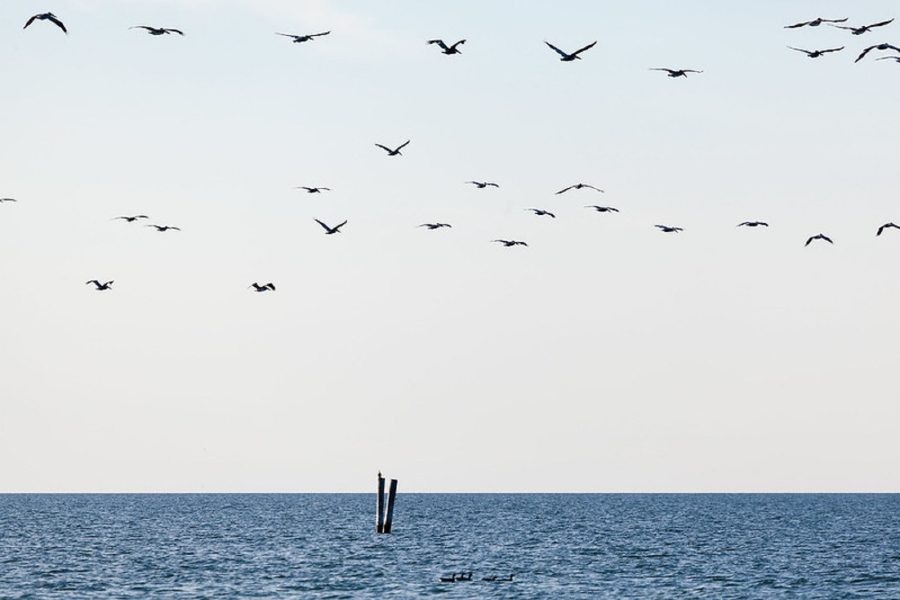Spring weather leaves researchers optimistic for a small summer dead zone
Ongoing efforts to reduce nutrient and sediment pollution also play a role

Each year, researchers from the Chesapeake Bay Program, University of Maryland Center for Environmental Science (UMCES), University of Michigan, United States Geological Survey (USGS) and Virginia Institute of Marine Science (VIMS) collaborate to forecast the volume of hypoxia that will be seen over the summer throughout the main portion of the Chesapeake Bay.
Hypoxia—or areas of low-oxygen—occur when excess nutrients, including both nitrogen and phosphorus, enter the water through polluted runoff and feed naturally-occurring algae. This causes algae blooms to grow out of control, and when they eventually die and begin to decompose, remove oxygen from the surrounding water. When this happens, plants and animal life are unable to survive, creating what we refer to as a dead zone.
Putting together this forecast each year is no easy task. In 2007, Chesapeake Bay Program scientists partnered with the University of Michigan, who had built a model that was being used to forecast hypoxia in the Gulf of Mexico and harmful algae blooms in the Great Lakes. Last year, this model was updated and transferred to the Chesapeake Bay Program.
While several different types of nutrients can contribute to the annual dead zone, it is nitrogen that causes the most havoc. The USGS monitors the amount of nitrogen entering the Bay from nine river input monitoring stations that are located on major tributaries: Appomattox, Choptank, James, Mattaponi, Pamunkey, Patuxent, Potomac, Rappahannock and Susquehanna. This information, along with data from wastewater treatment plants located downstream of these nine stations, also goes into the model to help develop the yearly forecast.
“These annual forecasts are a fine example of the collaboration that brings together high-quality monitoring data and cutting-edge science to support Chesapeake Bay restoration efforts,” said Joel Blomquist, a hydrologist with USGS.
More nitrogen can enter the Bay when we experience heavy amounts of rainfall during January through May, which is what occurred in 2018 and 2019. Precipitation can push harmful pollutants like fertilizers, pet waste, chemical contaminants and litter into the nearest waterways, so when the rainfall is in excess, more pollution than normal can be swept into the Bay and its tributaries. Additionally, heavy rain can cause erosion, particularly in areas where soil stabilizers, such as trees or grasses, have been removed, allowing even more sediment to be swept into waterways. The USGS also monitors river flows at their nine river input monitoring stations which helps inform the hypoxia forecast.
Take an especially rainy spring and a very hot summer with weak winds, and you have the perfect recipe for a large dead zone. Luckily, throughout the spring of 2021, we’ve seen below-average rainfall, meaning that less nitrogen has entered the Bay—19% less, in fact. The USGS recorded approximately 98 million pounds of nitrogen flowing into the Bay from their nine river input monitoring stations. Wastewater treatment plants downstream of these stations estimate they’ve released an additional 6.6 million pounds of nitrogen.
With all of these data points, what is this year’s forecast telling us? Well, compared to the last 35 years, experts estimate that the amount of hypoxia in the Bay will be 14% lower than average. Since last year’s dead zone ended up being 80% smaller than those monitored since 1985, this is a great trend to be on. A Bay-wide assessment of the 2021 dead zone will be available this fall.
Want to help track the dead zone over the summer? Be sure to visit the Maryland Department of Natural Resources’ (DNR) Eyes on the Bay website. DNR researchers conduct 8-10 cruises throughout the summer to track hypoxia in the Maryland portion of the Bay. Live in Virginia? Check out the VECOS website for the Virginia portion of the Bay or the VIMS’ daily real-time estimates of hypoxia.

Comments
There are no comments.
Thank you!
Your comment has been received. Before it can be published, the comment will be reviewed by our team to ensure it adheres with our rules of engagement.
Back to recent stories